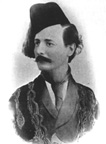[Eunice and Ron Shanahan have shared with readers of the Victorian Web this material from their website, Letters from the Past.]

In Sarah Searight's The British in the Middle East (London, Elton Press, 1979) Robert Hay comes very much alive and into the foreground. This book contains - amongst other things - a picture of Francis Arundale, pictures from his books and from Robert Hay's Illustrations of Cairo (1840) and pictures by Frederick Catherwood. Quotes from this book relate to the people mentioned in the letter:
"Wilkinson's long experience of excavation in Egypt, particularly in Thebes where he opened up several of the most beautiful tombs, made him foremost among pioneering archaeologists, among them the prosperous Scotsman Robert Hay, who financed many early excavations. Hay himself spent several winters between 1828 and 1836 living in a tomb in Thebes, excavating more tombs, drawing, cataloguing and recording finds and employing a group of draughtsmen and artists (including briefly Edward Lane) on similar ploys. Wilkinson and one of Hay's artists, Joseph Bonomi, became the greatest publicists of the new science of Egyptology." (p. 201)
During the 1820's and 1830's the dealer-collectors began to be replaced by more serious Egyptologists more intent on the record than the hoard. Robert Hay was typical of the new generation and was wealthy enough to employ a number of artists to make the record in which they were greatly assisted by the use of the camera lucida, a means of reflecting an image on to paper which Frederick Catherwood in particular among Hay's party used to great effect. Other artists who worked with or for Hay included Joseph Bonomi who had trained as a sculpture and Francis Arundale who had studied architecture and also painting under Pugin. Arundale first went to Egypt in 1831 and spent some nine years in the Middle East. During this time he accompanied Bonomi and Catherwood to Palestine where they were the first artists to win permission to enter the Muslim shrine of the Dome of the Rock in Jerusalem.
On the whole there was little creative art in the works of these men: that was not their task. What they were doing, under generally uncomfortable conditions, was what the camera today can do in a matter of moments - building up such a comprehensive record that modern archaeologists still refer to the forty-nine volumes of Hay papers in the British Museum to check on ruins which have since disappeared." (pp.238 - 241)
The Soane Museum in London most certainly has a basement full of bas reliefs. Caroline Simpson is responsible for the project to set up an exhibition of Robert Hay's Panoramas in Qurna. Malcolm Wright has created this web site about the project.
Last modified 10 December 2002